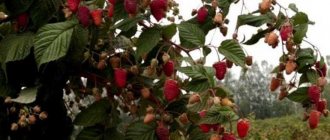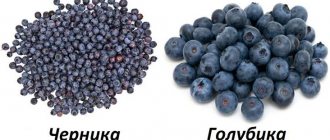Features of caring for blueberries
Care includes regular watering, fertilizing and pruning of bushes. Soil pH needs to be controlled. Blueberries are a self-fertile plant. For pollination, it is necessary to plant varieties with approximately the same flowering period in one area. Productivity will increase with the presence of pollinating insects. To protect the crop during the fruiting period, it is necessary to install bird repellers on the site.
Make sure there are no weeds in the beds. Mulching will help avoid the problem. The mulch layer needs to be updated periodically. The roots of the plant are shallow, so loosening and inter-row cultivation must be done carefully. Pests that can grow on blueberries include leaf rollers, aphids, beetle larvae and caterpillars. To combat insects, the drugs Calypso and Aktara are used.
A little about the benefits of blueberries
Blueberries are a storehouse of many minerals, vitamins and other substances that are vital for the human body.
Among the positive properties, their ability to help people with diseases such as atherosclerosis, diabetes, and diseases of the gastrointestinal tract in complex treatment should be highlighted. Blueberry dishes are quite useful for the prevention of diseases associated with the cardiovascular and nervous system.
By receiving the necessary set of vitamins with portions of blueberries, the human body copes well with acute respiratory infections, acute respiratory viral infections, and other infectious diseases. Even with such an insidious disease as dysentery, experts note a positive effect during treatment.
People who regularly eat such berries strengthen blood vessels and heart muscle. The functioning of the gallbladder and pancreas improves. However, if you are allergic to certain components, herbs and plants, you should use this product with caution. To avoid diathesis, it is better not to give berries to infants.
Features of autumn care
Caring for blueberries in the fall includes fertilizing, rejuvenating or formative pruning, watering and creating shelter. In autumn, the amount of watering and fertilizing decreases. By the beginning of September, it is necessary to carry out preventive spraying of plants against gray mold, moniliosis and anthracnose. For autumn treatment, use the preparations Ordan, Topaz, Skor.
From September to October, for the last time in the season, water the beds and cultivate the rows. When the crop is harvested, the bird scarers can be dismantled. From November the plant begins a dormant period. Caring for blueberries comes down to monitoring the condition of the shelters and periodically sprinkling the plantings with snow.
How to acidify the soil under blueberries: the best acidifiers
Thus, if you want blueberries to bear fruit abundantly and not suffer from chlorosis, then the soil under it should always be acidic (3.5-5 pH), which means you need to periodically acidify it.
Most gardeners say the simplest and cheapest way to acidify the soil is to use sulfur (you can buy regular ground, granulated in garden stores, or feed in veterinary pharmacies).
It is enough to apply 50-100 grams of sulfur once every 1-2 years per bush (a more precise dosage depends on the initial acidity and soil type).
Video: how to properly acidify blueberries with sulfur - the best way
You can also acidify the soil under blueberries with the following compounds and solutions:
- apple cider vinegar (100 ml of 9% vinegar per 10 liters of water);
- citric acid (20-40 g per 10 liters of water).
As for the frequency of applying such fast acidifiers, as a rule, they are applied every 2-4 weeks, at least 2-4 times per season (Important! This does not apply to sulfur, it is applied 1-2 times every 2 years). Video: how to acidify blueberries - watering with electrolyte
Video: how to acidify blueberries - watering with electrolyte
Folk remedies and acidic organic fertilizers
If you do not have the opportunity to purchase special acidic fertilizers or you are a supporter of organics, then you can acidify blueberries with the following fertilizers:
- Infusion of sour herbs. Cut the leaves and stems of the following acidic crops as finely as possible (rhubarb, sorrel, sorrel or hare cabbage are suitable), fill with water and let it brew for 2-4 days, water at the root.
- A solution of lemon juice (2-3 lemons per 10 liters of water).
Also, as a very light acidic fertilizer, you can mulch blueberries with sour red or high-moor peat, coniferous (spruce, pine) litter, rotted pine needles, and bark.
Video: how to feed blueberries
Thus, now you know how to properly feed and acidify blueberries. Yes, this is not such a simple matter, but the result is worth it.
Video: secrets of fertilizing and feeding blueberries
Pruning blueberries in autumn
An excessive number of branches makes it difficult to pick berries; the bush does not form correctly. Therefore, starting from the 3rd year of life, the plant requires pruning. The procedure significantly affects the life of the plant, the quality and quantity of the harvest. The goals of pruning are to maintain the growth and productivity of bushes, obtain large berries, and prevent pest damage. Pruning is performed with a sharp instrument treated with alcohol or another disinfectant solution. Damaged branches are treated with garden varnish.
Anti-aging pruning
To rejuvenate an adult shrub, 1–2 old shoots are removed for every 5–6 young ones. In subsequent years, you need to remove 20% of the old shoots and wait for the appearance of new ones. As new processes form, the procedure is repeated.
How is autumn pruning carried out?
Be sure to remove some of the branches in the fall, otherwise the blueberries will quickly degenerate into wild ones. You need to cut off all infected, old, dried, broken branches. If you ignore autumn pruning, too many young plants may grow. The shoots will be weak and small, since it is impossible to develop in a thickened crown. The bushes try to give all the nutrients to the young shoots, the fruits remain without nutrition. The berries become sour and their taste deteriorates.
The dense crown is a breeding ground for parasites and pathogenic bacteria; they begin to spoil the crop. Partial pruning is not only carried out in the fall. It is better to remove excess shoots all year round. In the spring, remove the frozen ends of the shoots; in the summer, remove the branches that thicken the blueberry bushes. Closer to autumn, sanitary treatment is carried out.
You may be interested in: How to cover roses for the winter, methods for covering rose bushes
Formative pruning of young and old plants
Formative pruning of bushes is necessary in late autumn, when sap flow has completely stopped. This is usually done from mid-October. Excess branches are removed, and the cuts are covered with garden varnish. This is necessary to prevent bacteria from getting inside the plant, which can cause infection. You should not prune later than November, otherwise the plant may be damaged by frost.
Some gardeners, having planted blueberries, do not prune them for one or two fruiting seasons. It is mistakenly believed that young shoots that grow during this period will be able to bear fruit in two years. But root shoots are produced, and buds are formed at their tops, to which the plant directs all its nutrients. Do not neglect pruning if you want to grow a good fruit-bearing tree.
If the seedling is planted in the spring, formative pruning is carried out in the fall to remove all growth at the base of the plant and diseased branches. It is necessary that there remains an even column 30 cm high without branches. When pruning an adult plant, only excess shoots are removed:
- horizontal in nature to the strongest vertical branch;
- sprouts of the third and second order, growing downwards and deeper;
- the upper parts of the shoots, infected with pests, damaged by frost;
- all shoots are less than 30 cm.
Anti-aging pruning
Rejuvenating pruning is necessary only for old plants. It is necessary to remove old branches, otherwise they thicken the plant, drawing all the nutrients onto themselves. Next year, the young growth will give good growth and give a rich harvest of delicious and juicy berries.
What fertilizers are applied?
Blueberries are fed with minerals. You can determine which microelements the bush lacks by external signs:
- calcium - deformation and yellowing of foliage at the edges;
- phosphorus - leaf blades turn red;
- potassium - the tops of young shoots die off;
- bora - the leaves become bluish;
- sulfur - the bush turns white;
- iron - fresh foliage turns yellow between the veins.
Important! Nitrogen should not be added in the fall. Organic fertilizers are also contraindicated for blueberries.
Features of storage of some types
How to protect dessert from spoilage in winter and protect it from negative influences? A moment that worries every housewife.
Cherry with pits
The shelf life of jam depends on an important factor - location. The correct location of the finished product is a refrigerator with a temperature of +10°C
To increase the shelf life of cherry jam with pits, you need:
- Open cans of last year's dessert.
- Pour the syrup into a separate container.
- Remove seeds from berries.
- Combine the fruits and liquid, bring to a boil over low heat, and simmer for several minutes.
A lower temperature will not benefit the berry dessert, and may also damage the jar. Cellar conditions are suitable only if the temperature is kept at +10 °C.
Apricot
Proper storage of apricot jam implies the following conditions. The most preferable place is a basement, cellar or refrigerator. If there are no suitable options, then you can prepare a fruit dessert by mixing berries and sugar in equal proportions. In this case, you need to add a little juice and zest of one lemon.
From pine cones
A healing dessert made from pine cones should be stored only in the correct container - glass jars, sterilized and completely dry. The best place is the refrigerator. You can use a dark and cold room without direct sunlight. The acceptable temperature for cone jam is 0-20 degrees and humidity up to 70%.
From black currant
Currant delicacy can be stored for 1-2 years at a temperature of +6-12 degrees. Under room conditions, the shelf life is 1-3 years. The pantry will allow you to store jam at a temperature no higher than +20 degrees. Storing the product in the cellar is not recommended.
With gelatin
Adding gelatin to accelerate hardening allows the jam to perfectly retain its shape and jelly-like consistency even at room temperature. Therefore there is no need to refrigerate. A cool place - a cellar or basement - is suitable for storing berry treats.
Cans of sweet mass prepared in this way do not explode.
Mulching the soil
The procedure helps preserve moisture, get rid of weeds and smooth out sudden temperature changes. Pine needles, crushed spruce or pine bark, sawdust or straw are used as mulch. The optimal thickness of the protective layer is from 5 to 10 cm. Every year it is increased by 5 cm.
You can also use fallen leaves. By spring they will rot and work as fertilizer. When using mowed grass or green manure crops as mulch, the plant mass must first be crushed. It is not recommended to use synthetic covering material instead of mulch - if the winter is warm, the plant will rot.
Compote
This compote is prepared without sterilization. To prepare a three-liter jar of compote, you will need 2 cups of fresh blueberries, which will be approximately 450 g, as well as a glass of sugar (you can change the amount to taste), 2 slices of lemon, a cinnamon stick (if you don’t like its smell and taste, don’t add it).
Cooking order:
- Sort through the berries and discard any that are overripe or spoiled.
- Wash the compote jar thoroughly with soda, then sterilize.
- Place the berries in a jar.
- Pour sugar into a jar and add lemon.
- Boil 2.5 liters of water and pour the contents of the jar. Leave for 20 minutes.
- Drain the water, put it on the fire, bring to a boil and pour it back into the jar of berries. Roll up, cool and store.
Blueberry compote is a healthy drink, but lacks a distinct taste, so, for example, lemon juice is added to it
Watering in winter
In autumn, the frequency of irrigation is reduced. In rainy weather the procedure is canceled. For irrigation, acidic water with a pH of 4–5 is required. To acidify the liquid, use citric or oxalic acid (1 teaspoon per 1 bucket of water). Watering is needed for:
- growth of the root system;
- protection against freezing of soil saturated with water;
- better wintering of the plant.
Important! The last watering should be done 2 weeks before the onset of stable frosts.
Irrigation is carried out using a divider, which prevents soil erosion and exposure of the root system. The top layer of soil should be saturated to 40 cm. On average, one three-year-old plant requires a bucket of water. The timing of irrigation varies by region. In central Russia this is mid-September, in the south of the country - early October, in the northern regions - the beginning of the first month of autumn.
Frozen blueberries: how to store berries in the freezer
Blueberries are best consumed fresh, but since this berry does not tolerate long-term storage, you have to think about how to preserve it for the winter. Blueberries are used to make jam, paste and homemade wine. But these preservation methods are not able to preserve most of the vitamins. Only freezing can cope with this task.
What kind of berry is blueberry?
Blueberry is a shrub 30–50 centimeters high. Some varieties can reach 1 meter in height.
The fruits of this plant are quite large, juicy, dark blue in color with a bluish tinge. The berries are large, up to 1.3 centimeters in diameter.
Blueberries are very healthy. It is indicated for people with diseases of the cardiovascular system and digestive tract. Constant consumption of these fruits helps relieve tension in the eye muscles and restore vision.
Watch the video from the channel “Chan Kazan” - Very healthy blueberry
The difference between blueberries and blueberries
Comparing these two berries, it will not be difficult to find differences between them. So:
- on a blueberry bush the stem grows woody almost to the very top;
- The blueberry bush has light-colored stems;
- The receptacle of blueberries is smooth, but the line of blueberries is not straight, broken.
- the taste of blueberries is brighter and more pronounced;
- The juice secreted by blueberries is light, while that of blueberries is dark purple with a red tint.
- blueberry juice is very difficult to wash off, and blueberries do not stain your hands;
- The pulp of blueberries is pink-red, while blueberries have a greenish tint.
Preliminary preparation
Blueberries should be picked in dry, sunny weather. Since the berry is very vulnerable, the picking must be done carefully so as not to deform the fruit.
If you bought blueberries at the market or in a store, you need to rinse them with water before freezing. It is best to do this in a large container, rather than exposing the berries to pressure from the tap.
Dry blueberries on waffle or paper towels. The key to quality freezing is a completely dry product.
Whole berries
The berries are placed in containers or trays in a layer of no more than 2 centimeters. In this form, the blueberries are sent to the freezer. It is advisable to set the freezer to “Super frost” a couple of hours before. After 4 - 6 hours, the blueberries can be taken out and poured into a common bag or container. Freezing this way allows you to freeze the berries in bulk.
Blueberries with sugar
Place the berries in containers and sprinkle them one by one with granulated sugar. The amount of sugar is taken according to your own taste, but experienced cooks advise using 3 - 4 tablespoons per half kilo of blueberries.
Blueberry puree for the winter
Puréed blueberries are a great option for freezing. If you like to feel the structure of the berries in a dish, then you can chop the blueberries with a regular wooden masher. If you want to see a more homogeneous mass, then a blender can come to the rescue. It is recommended to add sugar to this preparation. Its quantity depends on your taste preferences, but you should not add too much sand. For 1 kilogram, 200 - 250 grams will be enough.
Tanya Nikonova in her video will tell you how to make natural juice from blueberries or blueberries in a blender
Shelf life of blueberries in the freezer
Blueberries tolerate freezing very well, so the berries do not lose their taste and beneficial properties throughout the whole year in the freezer.
The optimal storage temperature for blueberries is -16…-18ºС and below.
In order not to confuse blueberries with blueberries or, for example, with grated black currants, the preparation must be labeled. On the tag you can indicate the type of berries, the method of freezing and the date of placing in the chamber.
Sheltering blueberries for the winter
Sellers of seedlings claim that blueberries can tolerate frost down to -35 ºС. In fact, only certain varieties (Patriot, Eriblu) can withstand such temperatures. Why is the lack of winter shelter dangerous for blueberries:
- in tall varieties, the shoots and fruit buds on them freeze;
- if there is little snow and severe frost, the root system will freeze;
- winter hardiness of blueberries decreases when grown on poor acidic soils;
- Improper pruning and excessive watering negatively affect the plant.
In the south of the country, it is enough to mulch the soil around the root system of the bush. In Belarus, Ukraine and regions of central Russia, bushes are covered with agrofibre, spunbond or burlap. First, the plants are bent to the ground and secured with twine. Preparing blueberries for winter in the harsh climatic conditions of the far north includes installing a wooden or metal frame. The structure is covered with covering material and secured with twine.
Airtight materials such as roofing felt and plastic film cannot be used as shelter. When the air temperature rises, the plant will rot, and if there are repeated frosts, it will freeze. In frosty weather, it is recommended to insulate the plantings with snow. During periods of warming, open the shelter slightly for ventilation. With the onset of spring, the covering material is removed in stages.
Shelter materials
Materials for covering strawberries can be either natural or artificial. Their main task is to keep plants alive and healthy until the onset of spring warmth.
Natural covering materials can serve as:
- spruce branches,
- dry stalks of corn or reeds,
- fallen tree leaves,
- sunflower stems,
- peat or humus,
- hay or straw
- tyrsa (shavings),
- own strawberry foliage, etc.
When covering strawberries with natural materials, give preference to those that will not only warm the plants in winter, but also saturate the soil with useful substances when the snow begins to melt (humus, peat, etc.).
Agrofibre
Modern amateur gardeners do not bother collecting dry leaves, pine needles or sawdust to cover strawberries - they replace them with agrofibre. It is an environmentally friendly, non-woven material that has undergone special anti-UV treatment. Very light, transmitting sunlight and allowing plants to breathe, this material can protect bushes from frost.
Agrofibre has many analogues:
Straw
Straw is a natural protection for plants, which not only protects from frost, but also prevents plant rotting. The fact is that straw is capable of releasing fungicides - disinfectants that fight mold and fungi. Strawberries under such protection are not only warm, but also healthy.
Foliage
The foliage of broad-leaved trees is an excellent covering material for strawberries. Summer residents give the greatest preference to oak leaves - they are less susceptible to rotting than others, and, therefore, can serve for a long time as a winter “blanket” for bushes.
Spruce and pine spruce branches
You can build excellent protection for strawberries for the winter from pine or spruce branches. Needles can not only retain heat in the garden bed, holding a thick layer of snow, but also protect strawberry bushes from unwanted attacks by rodents: voles, mice, etc. These animals do not like the smell of pine needles.
Inorganic and organic mulch
Inorganic mulch, which uses pebbles, stones, sand, gravel, black polyethylene, etc., is good because it does not attract parasites and plant pests, and also does not decompose and can serve as cover for many years. In contrast, organic mulch is subject to decomposition, attracts various insects, but perfectly saturates the soil with useful substances.
What kind of strawberry crop you will harvest in the new season depends only on you and the method of plant protection you choose. Treat this procedure with full responsibility and care, the result will not disappoint you!
Blueberry season is ending and you are harvesting your last crop. What to do next? Obviously, you need to somehow prepare the berry bush for winter.
Preparing for winter by region
Blueberries are covered in several stages. At the beginning of autumn, the mulch layer is renewed. When the leaves fall, the shrub is bent to the ground and a frame is installed. After the onset of frost, blueberry bushes need to be covered with straw, spruce branches or reeds. At temperatures below -25 ºС, the frame is wrapped with covering material. The timing of preparation for winter by region is approximate. It is necessary to rely on the weather forecast.
Preparing blueberries in the Moscow region
The deadline for warming blueberries is early October. By this time, the root system and shoots of the bush should be covered. In case of severe cold, you can use the same shelter as for the northern regions.
Preparation in Siberia
Winter comes early in the north and weather conditions are unpredictable. For cultivation in Siberia, it is necessary to purchase zoned varieties adapted to the climate of the region - Divnaya, Taiga Beauty, Northern Country. The plants are low growing and easier to care for in the fall. They tolerate winter well. The deadline for completing the work is the end of September.
Blueberries: storage and processing
Previously, blueberries were considered a wild berry, but recently the fashionable trend of growing this berry in gardens has been gaining momentum. And this is not surprising, because these tiny and very tasty berries can relieve stomach problems, improve blood composition and even cure coughs. And during the Second World War, British pilots feasted on blueberries and blueberries to improve their eyesight. Well, since this beautiful berry has reached our latitudes, the question of how to properly store it became quite natural.
How to choose a good berry?
You need to buy only ripe blueberries, since after picking the delicious berries no longer ripen.
Therefore, it is extremely important to choose only blue berries that do not have reddish tints. In addition, the blueberries must be quite strong and elastic.
You should not buy watery and soft berries, as well as berries with mold.
Anyone who grows blueberries in their own garden needs to know that the taste of the berries is greatly influenced by weather conditions. For example, when dry weather sets in due to lack of moisture, the growth of blueberries is significantly inhibited, and the berries often turn out to be insufficiently saturated and small. And heavy rains often lead to rotting of the skin of the fruit, which is also extremely undesirable.
You need to harvest blueberries very carefully, trying not to damage the incredibly delicate skin of the berries, otherwise preserving the harvest will be very problematic. Fresh, undamaged berries can be stored for two weeks.
However, ideally, after purchasing or picking blueberries, it is recommended to either eat them immediately or process them. After all, if juice begins to form in containers with stored berries or moisture appears, the blueberries will become unfit for consumption. In addition, during storage in the refrigerator, it can be affected by diseases such as anthracnose or gray mold.
Fresh, undamaged berries can be stored for two weeks. However, ideally, after purchasing or picking blueberries, it is recommended to either eat them immediately or process them. After all, if juice begins to form in containers with stored berries or moisture appears, the blueberries will become unfit for consumption. In addition, during storage in the refrigerator, it can be affected by diseases such as anthracnose or gray rot.
Freezing blueberries
Blueberries freeze well. By the way, it is strictly not recommended to wash it before freezing, since under the influence of water the skin of the berries almost always becomes hard. Douse blueberries with water immediately before serving, after the berries are removed from the freezer.
In order to freeze blueberries, place the berries in tightly closed containers, leaving about three centimeters of free space - there is no need to fill the blueberries to the top. Containers filled in this way are sent to the freezer. You can also freeze the berries in a syrup made from water and sugar in a ratio of 4:3. The berries are poured with this syrup directly into containers, after which the container is tightly closed and placed in the freezer.
If you plan to use frozen berries to prepare various dishes, it is important to try to prevent them from completely thawing before adding them to the prepared dishes. This trick will preserve their structure, prevent the berries from releasing juice and prevent the dish from discoloring.
Drying blueberries
Another option to preserve blueberries for the winter is to dry them in the oven. The berries are sorted and cleaned of foreign impurities, after which they are thoroughly washed and placed in a colander so that the water completely drains from the blueberries. Then the berries are placed on a baking sheet and placed in an oven preheated to forty-five to fifty degrees. The blueberries are kept in the oven for about two hours. Do not close the oven door completely, but stir the berries from time to time - they should dry evenly. After two hours, the temperature in the oven is increased to sixty to sixty-five degrees and the berries are dried for about another hour.
Dried blueberries are transferred to suitable containers and stored in a dry place.
In addition, blueberries can always be preserved - the preparations from them also turn out incomparable!
Common mistakes
Novice gardeners who start growing blueberries in their garden make a number of mistakes:
- place the seedlings in partial shade - the growth of the bushes slows down, the fruits will be small and take longer to ripen;
- early planting of the bush - it is recommended to plant 2–3-year-old bushes in open ground;
- frequent loosening leads to drying out of the root system;
- lack of shelter for the winter - the roots and shoots of the plant will freeze, which will lead to the loss of bushes;
- Growing blueberries in soils with high acidity - the bushes will lag in growth.
Important! To maintain optimal acidity, water the soil with a solution of citric acid - 2 tsp is required for 3 liters of water. active substance.
Blueberries can be grown in one area for 5 years. After this period, the shrub is transplanted to a new place or the area is well fertilized. The best neighbors for blueberries are other berry bushes - cranberries, currants, raspberries. Conifers can be planted around the perimeter of the berry garden - the trees will protect the plantings from cold winds. It is not recommended to plant blueberries next to fruit trees.
The shrub grows poorly in dense plantings. When the branches are crowded, the plants are shaded and elongated. Grow blueberries in open, sunny areas where there are no drafts or strong winds. To get tasty and aromatic berries all season long, plant blueberry varieties with different fruiting periods.
Blueberry wine
Experienced winemakers know a lot about wine made from ripe wild blueberries. But today any owner can prepare such a delicious drink for himself. It will be quite appropriate on the holiday table.
It should be said that this wine is very good for health (in moderation, of course).
Required ingredients for making wine:
- Drinking water - 5 liters;
- Sugar – 1900 g;
- Fresh blueberries – about 4000 mg.
Stages of making wine from blueberries:
- Blueberries are first sorted, choosing the best fruits (this is important, as it will affect the quality of the finished product), and washed;
- The berries are mashed;
- Squeeze the juice out of the resulting mass (using a sieve or gauze);
- The resulting pulp should then be filled with water and infused for about 24 hours;
- The resulting infusion is poured and combined with the juice that was originally obtained;
- Then sprinkle everything with sugar and stir with a spatula so that the sugar dissolves;
- The resulting wine preparation is poured into a large bottle - up to the “shoulders” of the container and covered with latex (providing a hole for carbon dioxide to escape);
- The bottle of future wine is placed in a dark room, where it begins to ferment, accompanied by the release of bubbles;
- When the number of bubbles decreases, it can be said that the wine needs to be drained;
- It is poured into another container using a special hose with a small diameter;
- After the wine is poured into another container, it must be sealed and placed in a cool room for 60 days (no less);
- The finished, settled wine is poured into small bottles and stored for 12 months in a cellar or pantry.
Orange jam
Before making one-ingredient jam, it’s worth finding out how you can diversify the usual taste. Blueberries go well with citrus fruits, which is why the orange jam recipe is especially popular.
READ ALSO: Radiant Kishmish grapes description of the variety, rules of care and breeding
When preparing, you must use the following ingredients:
- blueberry fruits – 1200 grams;
- freshly squeezed orange juice - a third of a glass;
- lemon juice – approximately 70 grams;
- orange zest (pre-grated) – a tablespoon;
- 6 glasses of sugar - it is useful to use unrefined cane product;
- cinnamon - optional.
Pour berries into a container prepared in advance, pour in juice (lemon and orange), and add chopped zest. Add sugar and cinnamon, mix thoroughly.
- Cook the resulting mixture over medium heat until the sugar crystals are completely dissolved. Next, you need to increase the temperature and, stirring, cook the jam for another 10 minutes.
- Remove the dishes from the heat, cover and leave for 12 hours.
- Light the fire again and place the container on it. Cook until the syrup thickens slightly. When the jam has cooled a little, you can pour it into the prepared jars.
Thanks to the zest and cinnamon, the resulting jam has a truly delightful aroma that will attract all the inhabitants of the house, and if the windows are open, the neighbors.
How and with what to fertilize
You need to start with the most important thing - in the autumn, under no circumstances apply organic fertilizers to the bush , be it compost, humus or fallen leaves. Otherwise, instead of the blueberry “falling asleep” with the arrival of winter, it will, on the contrary, begin to awaken to life again, blooming leaves and flowers.
Also, because of this effect, you should refrain from adding nitrogen to the soil in the fall. Typically, soil fertilization occurs after sanitary pruning, when all dried, diseased and old branches have been removed from the bush.
This is done so that the already unnecessary parts of the blueberry do not take away nutritional elements, which in the end may not be enough for the younger shoots.
First, each bush needs to be watered well, using 4-5 buckets of water.
After moistening the soil, 40 g of double superphosphate and 40 g of potassium sulfate should be added to each plant.
Usually, for better absorption of fertilizers, they are applied directly into the ground, but since the blueberry root system is located very close to the surface, doing this is highly not recommended. It’s better to pour superphosphate and potassium at the base of the bush and sprinkle the minerals with soil.
Variations for gourmets
If you have a creative nature, then a simple blueberry recipe for the winter will not satisfy you. You will probably want to improvise and add your own ingredients to this creation. To get a real “masterpiece”, many add raspberries, cherries, cherries, and currants.
Some particularly creative people go further and even add alcoholic drinks, which add some “zest” to the taste.
To give an unusual aroma, blueberry jam is “enhanced” with spices. The most suitable are:
- Carnation;
- Cinnamon;
- Vanillin;
- Lemon or orange zest;
- Cardamom;
- Nutmeg.
Fresh blueberries with sugar for the winter
Finally, lovers of the healthiest food prepare “live” blueberry jam, that is, the berry is not thermally processed in it, which means all the beneficial substances are preserved.
You will need:
- 1 kilogram of berries;
- 2 kilograms of sugar.
Step by step recipe
- Cover the berries with sugar.
- The resulting mixture is finely ground in a blender or mixer.
- “Live” puree is simply stored in the refrigerator.
Sugar acts as a preservative and prevents the berries from going to waste.
In any case, in winter, blueberry jam will be a wonderful table decoration, accompanying family tea parties and friendly companies.
Separately, it is worth noting the benefits of blueberries for the female body:
Blueberries normalize the regularity of the menstrual cycle.
Improves the activity of the endocrine glands.
Improves not only skin color, but also its appearance.
Removes bile and relieves swelling, including under the eyes.
In small quantities, blueberries are extremely beneficial for pregnant women due to their calcium content, which is very important for the future development of the baby.
After childbirth, a woman’s hair and nails will be well preserved if she consumed blueberries during pregnancy.
This berry has so many advantages that not only a separate article, but also a scientific work can be devoted to this. But the question is: how to preserve it for the winter, so that in winter you can receive the necessary dose of useful microns with which this berry is full? We hope you enjoy these simple winter blueberry recipes.
Of course, to get the most benefits from blueberries, you need to eat them raw. However, even in cooked form it is very useful.
As you can see, blueberries are a real boon for those who like to cook delicious and healthy dishes with their own hands. Cook for health, experiment and share your recipes!
Blueberries are somewhat similar to blueberries, but have larger fruits. Its color is deep blue. And the taste is a little tart. But this is not a reason to avoid this berry
It is worth paying more attention to it. One way to prepare it for a long time is to make jam.
The technology is simple, even a beginner can handle it. Therefore, while the harvest season is underway, you need to have time to make blueberry jam for the winter. The berry has an anti-inflammatory and antipyretic effect. By consuming just a spoonful of this jam at breakfast, you can get a boost of energy for the whole day, boost your immunity and protect your body from seasonal viral diseases.











